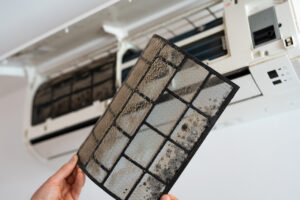 The one-word answer is water. There are actually five factors that are needed to support fungal growth, but water is the factor most easily controlled indoors and is the one factor every species of mold requires. The other factors are temperature, light, nutrients (food source), and PH (molds prefer a slightly acidic environment).
The one-word answer is water. There are actually five factors that are needed to support fungal growth, but water is the factor most easily controlled indoors and is the one factor every species of mold requires. The other factors are temperature, light, nutrients (food source), and PH (molds prefer a slightly acidic environment).
Water can also be the result of excessive humidity. In every home, we have spaces with poor ventilation such as a basement, attic, cabinets, and bathrooms. Using a dehumidifier is one of the most common ways to try and eliminate humidity, but it is not the only solution.
Some sources of moisture which can lead to mold growth are leaks or broken pipes, or a water-saturated floor that is not dried quickly due to poor ventilation of the area. These circumstances, if not fixed immediately, create the perfect environment for mold to grow.
Do not ignore the early signs of mold in your home. If you can smell mold in your home or you have had wet building materials for more than 72 hours, then it may be time to call the professionals at Mold Solutions. We test, treat, and remove mold using the best practices we have developed over the last 11 years. Not only that, we provide you with relevant information about what mold is, how it grows, and what you can do to prevent its spread.
Mold and Bacteria are Microorganisms
Mold shares its classification with yeasts and mushrooms. While bacteria is unicellular, or structurally a one-celled organism, mold is multicellular. However, mold and bacteria do have one thing in common: they thrive in a humid environment.
Even though mold can be beneficial in laboratory settings, just like bacteria and viruses, mold is considered a severe threat to human health.
Mold Reproduction
Mold spores can perform asexual reproduction by mitosis or meiosis. Mitosis and meiosis are the two types of cell division that cause molds to grow and reproduce. Fungi are heterotrophic and saprophytic because they cannot produce their own food and must rely on an external food source that is high in cellulose.
During reproduction, cells called mold spores are distributed or scattered in the environment. Mold spores are too small to be detected by the naked eye. You will not notice their presence or be able to avoid exposing yourself to them at the early stage of their existence. Once spores enter the environment, they can end up everywhere inside your home.
The Role of Hyphae in Mold Growth
Hyphae are thread-like structures present in the mycelium. Mycelium is a network of numerous hyphae that make up the multicellular fungi. They are tiny and feathery with rigid cell walls to protect the spores. Aside from cell walls, the mycelium has septa, or divisions, adding more protection to mold spores.
When hyphae release spores into the air, the spores germinate like plant seeds growing into a new hyphae cell, and this process is repeated until many hyphae are formed. This happens fast, especially if the environmental conditions are favorable, such as when the environment contains minimal light, excessive moisture, and a food source is present. The moisture level required for mold growth is greater than 60 percent relative humidity.
How to Stop Mold Growth and Reproduction
The use of dehumidifiers is an effective way to keep relative humidity levels in an acceptable range. Most indoor environments have a relative humidity of 40-50% when the temperature is between 68-72 degrees Fahrenheit. To prevent mold growth and reproduction, you will need to do some detective work and resolve the source of any moisture intrusion.
If you cannot find any mold but are suspicious, consider calling in a professional. We accurately assess the problem and take appropriate action. Let us make your life easier by removing the mold from your home. Call us now!







